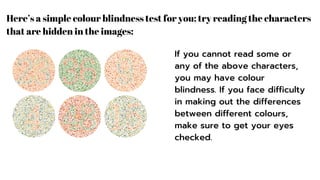Educate Yourself On Colour Blindness
- 2. Introduction A greater part of the process in which the eyes perceive colour, depends on how healthy the cones are. Cones, located in the retina, are photoreceptor cells which contain pigments that react to a different wavelength of light. In other words, they are responsible for coloured vision. Unfortunately, not all eyes have healthy cones and, therefore, they face difficulty in colour perception. This condition is described as colour blindness.
- 3. HereŌĆÖs a simple colour blindness test for you; try reading the characters that are hidden in the images: If you cannot read some or any of the above characters, you may have colour blindness. If you face difficulty in making out the differences between different colours, make sure to get your eyes checked.
- 4. Different Types Of Colour Blindness Did you know that thereŌĆÖs not just one but several types of colour blindness? Yes, the impaired function of the conesŌĆÖ photopigments in the eyes differ from person to person. Meaning, some people are less sensitive to particular colours.
- 5. Some Of The Most Common Types Of Colour Blindness Include:
- 6. Blue-Yellow Colour Blindness A type that occurs when the blue photopigments in the cones do not function properly. Blue-Yellow Colour Blindness can also occur if the blue cone photopigments are missing. This type of colour blindness affects men as well as women.
- 7. Red-Green Colour Blindness Red-Green Colour Blindness occurs when the red and green cones do not work partially or fully. The two common types of Red-Green Colour Blindness include Protanomaly and Deuteranomaly.
- 8. Complete Color Blindness People with complete colour blindness see limited or no colour at all. There are two types of complete colour blindness: Rod monochromacy and Cone monochromacy.
- 9. Causes Of Colour Blindness
- 10. Age Cataracts Optic nerve damage Physical injury to the eyes
- 11. Risk Factors For Colour Blindness
- 12. Macular Degeneration Diabetes Glaucoma Sickle Cell Anemia Leukaemia ParkinsonŌĆÖs Disease AlzheimerŌĆÖs Disease Regular alcohol consumption
- 13. Treatment For Colour Blindness
- 14. ThereŌĆÖs no ultimate treatment for colour blindness. Often, eye doctors choose eyeglasses and contact lens with filters as the treatment option to adjust colour deficiencies. These eyeglasses and contact lenses can make up for colour blindness by adjusting the contrast between different colours.
- 15. Visit Disha Eye Hospital For High-Quality & Affordable Eye Care Address: 88 (63A), Ghoshpara Road,Kolkata- 700120. West Bengal, India. Appointments:(033) 2545-1233/1235/ 1236/ 1237/ 1238; 2593- 1729/3737; 2594-4586/7809/7810SMS Appointment: 9433311111 Fax: (033)-2592-8106TPA Helpdesk: (033) 6460-6560 Email: dishaeyehospitals@gmail.com















